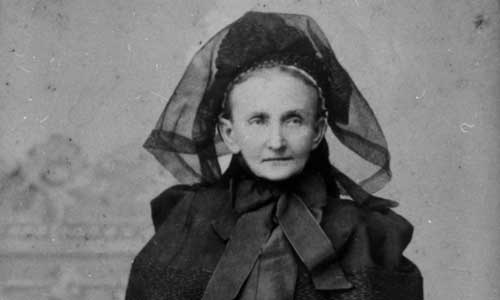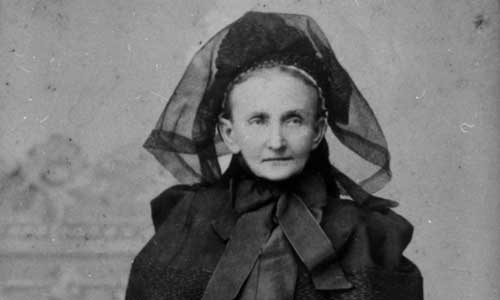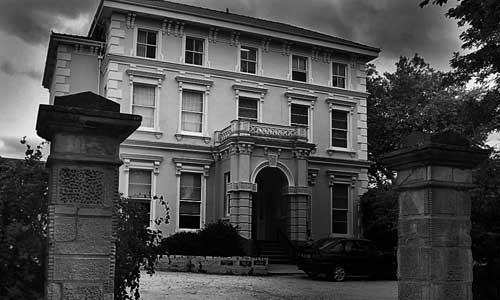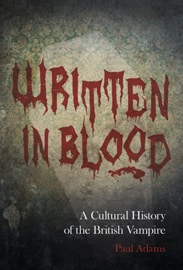PAUL ADAMS delves into the frightening case of the Cheltenham Poltergeist and the birth of ghost-hunting
The current explosion of popular ghost hunting which has taken place in this country over the past 10 or 12 years has created a vast array of investigative groups and organisations which currently jostle for space in an increasingly overcrowded paranormal scene.
The fallout from this modern blast of enthusiasm for ghosts and hauntings rains a bewildering array of nocturnal vigils, EMF detectors, trigger objects, EVP recorders, ‘orbs’ and websites on the public at large and makes it difficult to recall what the rather more obscure occupation of ghost hunting was like even a quarter of a century ago, when small organisations and a handful of individuals carried out what then was an almost amateur and overtly clandestine hobby-like interest.
Turn the clock back further for say a hundred years or so and we would appear to have lost touch entirely with the way that paranormal phenomena was approached and, with the founding of the first serious organisation into the subject, the Society for Psychical Research (SPR) in 1882, how it was studied and reported.
What is surprising then is that one of the most respected historical accounts of a case of haunting that has been set on record comes from that time – the closing decades of the nineteenth century – and the presenter of this evidence was not a gadget-ridden amateur scientist but the young daughter of a retired Victorian army captain.
The ‘Cheltenham Haunting or ‘Morton Ghost’
The ‘Cheltenham Haunting or ‘Morton Ghost’ as it is often described first came to public attention in 1892 when an account was published in the Journal of the SPR under the title Record of a Haunted House.
This was partly at the instigation of Frederick W.H. Myers, one of the founders of the SPR who was then currently living in Cheltenham and after hearing an account of the haunting became interested in the case. The identity of the family concerned and the location of the house itself were concealed when the haunting first came to light, the SPR paper being written by a ‘Miss R.C. Morton’. It was not until 1948 when all the principal witnesses were dead that the basic facts of the case were published for the first time.
Myers became involved in 1884 when the haunting was in progress and had actually reached what was to be its peak. Principal phenomena lasted in total for a period of seven years from 1882 to 1889 although there is a body of evidence for it continuing for periods until relatively recent times. In the main the haunting comprised the appearance of the figure of a tall woman dressed in black invariably with her features partly concealed by a handkerchief held up to the lower part of her face. This combined with the dark clothing gave the apparition the appearance of someone wearing ‘widow’s weeds’ or at least in the aspect of mourning.
The real ‘Woman in Black’?
Queen Victoria set the standard for mourning in Victorian times. She wore black for the rest of her life following the death of Prince Albert and the Victorians had a powerful funerary industry; large imposing cemeteries filled with monuments and symbolism; catalogues of the latest funerary fashions and accessories.Women dressed in black, they were everywhere, a common sight in every village, town and city. The ghost seen at Cheltenham was accepted as being that of a woman in mourning. It was seen by several members of the same family as well as by their servants and also by a neighbour, under what appear to be excellent conditions of observation, often in daylight and often for considerable periods of time.
Unlike a number of famous historical hauntings, such as Borley Rectory, Langenhoe church and Hinton Ampner, the building involved still stands at the corner of Pitville Circus Road and All Saints Road in the Pitville district of Cheltenham in Gloucestershire.
Built in 1860 on the site of a former market garden it was a grand double-fronted four storey Victorian residence of the time laid out over four floors. It stood in a considerable plot of land with a modest carriage drive to the front and extensive lawns and an orchard. This no doubt was the origin of the name ‘Garden Reach’ by which it was first known. Today, although the house survives, these grounds have seen much change – an estate of small bungalows known as St Anne’s Close has been built in the former garden and several of the buildings in the area have been demolished and replaced by blocks of flats.
‘Garden Reach’ was bought from its builder by Henry Swinhoe, a solicitor from Calcutta. He had married Elisabeth Francis Higgins on 6 February 1851 in India and they eventually raised a family of five children. However, Elisabeth died aged 35 on 11 August 1866 and four years later Henry Swinhoe married again. His second wife was Imogen Hutchins of Clifton, Bristol, but their relationship was marred by frequent quarrels, apparently over the upbringing of Swinhoe’s children as well as the possession of the former Mrs Swinhoe’s jewellery for which Henry had a secret hiding place fashioned under the drawing room floor.
Things were not helped by Henry Swinhoe’s descent into alcoholism for which there are conflicting accounts. One version states that Henry, stricken with grief, turned to drink after Elisabeth’s death and soon Imogen herself also became a drunkard. However, when author Andrew Mackenzie, who spent many years researching the Cheltenham case, interviewed one of Henry Swinhoe’s surviving granddaughters she put the blame on Imogen who was said to have been addicted to drink, a fact which Henry only discovered after they were married and it was she who encouraged her new husband onto the road to ruin. Whatever the real facts of the matter, Henry and Imogen Swinhoe separated early in 1876 – Imogen returned to Bristol while Henry lived on at ‘Garden Reach’ for a few months before dying on 14 July of the same year. Imogen in fact only outlived her husband by just over two years. She died at Clifton on 23 September 1878 but was in fact buried at the Holy Trinity Church in Portland Street, Cheltenham, quite close to her former home.
Following Henry Swinhoe’s death the house remained empty until 1879 when it was renamed ‘Pitville Hall’ and bought by Benjamin Littlewood from nearby Shurdington, a village on the southwestern outskirts of Cheltenham. His ownership was short-lived as he died on 5 August 1879 only a month after moving in and his widow soon moved to a smaller house in the same road. The house remained unoccupied for two and a half years until March 1882 when a tenancy on the building, now known as ‘Donore’, was taken by Captain Frederick W. Despard and his family. These are the ‘Morton’s’ of the SPR report. The Despards lived at ‘Donore’ for just over ten years, eventually leaving in 1893.
The Despards, a large middle-classic Victorian family
The Despards were a typical large middle-class Victorian family, affluent enough to run a good-sized house such as ‘Donore’ with live-in servants, a coachman and a gardener. Frederick W. Despard, an Irishman by birth was in his early fifties at the time. Retired from Her Majesty’s Army he was a well-travelled man if the evidence of his children’s birth certificates is anything to go by. His first wife Rosina Meredith Despard died in Cheltenham in 1858, most likely in childbirth with his eldest daughter Freda, and he wasted little time in getting married again, wedding Harriet Ann Nixon the same year. By the time the family eventually settled in ‘Donore’ several years later, Freda had married a South African solicitor named Herbert Kinlock and the couple continued to visit her parents.
From Cheltenham the Despards moved to Malven, Tasmania, where their next eldest children Rosina and Edith were born – Rosina in 1862 and Edith in1865. Two more daughters, Lilian and Mabel, arrived in St Helier on Jersey in the Channel Islands in 1869 and 1870 and their first son Henry appeared back in England at Clifton in Gloucester in 1867. Finally young Wilfred Despard completed the family line up and brought it full circle by being born in Cheltenham in 1876.
The principal witness of the appearance of the ghostly woman in black was Rosina Clara Despard, 19 years of age when the phenomena began who later went on to qualify as a doctor of medicine. She took her ‘Preliminary Scientific Examination’ in 1886 while the haunting was still in progress and which was also the time that Frederick Myers met the Despard family personally for the first time. Rosina kept written records of the appearances of the apparition from the very beginning in the form of letters to a friend, Miss Catherine Campbell, and from this correspondence the 1892 report in the SPR’s Journal was eventually compiled.
Unfortunately Rosina’s original letters themselves do not appear to have survived, Miss Campbell declining to present them to the SPR as they contained private and personal information as well as reports of ghostly phenomena. This led to later speculation by Dr Eric Dingwall, a long-standing member of the SPR and a former Research Officer, that the two women were involved in a lesbian relationship. Whether this is true or not has no bearing on the quality of Rosina’s reporting of her experiences. For the record Dr Rosina Despard did not marry and after a medical career for which in part she was the Assistant Medical Officer at the Holloway Sanatorium, died at Yarmouth on the Isle of Wight in 1930.
At the end of April 1882, two months after the Despards established their new household at ‘Donore’, Rosina saw an apparition for the first time. One evening after retiring to her room she was disturbed by the sound of someone at the bedroom door. Thinking that it may have been her mother, who we are told was an invalid who did not enjoy the best of health, she stepped to the door and on opening it reported the following:
“ I saw no one; but on going a few steps along the passage, I saw the figure of a tall lady, dressed in black, standing at the head of the stairs. After a few moments she descended the stairs, and I followed for a short distance, feeling curious what it could be. I had only a small piece of candle, and it suddenly burnt itself out; and being unable to see more, I went back to my room.”
This extract from Rosina Despard’s report to the SPR demonstrates just how distanced we are from the days when ghost hunters pursued their quarry by the shadowy light from a guttering candle. Rosina goes on to describe the figure as being dressed in soft woollen material and mentions the figure’s singular aspect of holding a handkerchief up to its face so partly obscuring the features. This together with the impression of a bonnet with either a long veil or a hood gave the figure the aspect of being that of a woman in mourning. Between the time of this first appearance and July 1884, Rosina saw the figure a further half a dozen times but told no one other than her confidant, Miss Campbell.
However, Rosina was not the only one during this two year period to see the figure of the woman in black. Rosina’s married sister Freda saw a figure which she thought was a visiting nun cross the hallway one evening, while a housemaid also saw a figure which she took to be an intruder. In December of the same year young Wilfred Despard was on the terrace outside the drawing room with a playmate when both boys saw a woman in obvious distress standing near to the drawing room window. Going inside they found the drawing room empty and were told by the parlour maid that no one had called at the house up until that time. During this period Rosina often attempted to communicate with the figure but received no response.
Haunting reaches its peak in July and August 1884
The haunting reached its peak between July and August 1884 when appearances of the figure were at their maximum. Rosina claimed to have seen the ghost stand silently at the drawing room window for nearly half an hour and her sister Edith reported the unnerving experience of being passed by a tall figure on the stairs during the night. Footsteps were also heard on the landings by both family members and staff. Rosina attempted experiments by stretching cords across the staircase which she said the apparition always appeared to pass through and remained unbroken. On another occasion she also reported opening a door and allowing the ghost to pass through.
On 5 August 1884, Rosina spoke to Frederick and Harriet Despard about the apparition for the first time. Despite being “much astonished” about what his daughter had to say, especially as he and his wife had not experienced anything themselves, the Captain evidently took Rosina’s claims seriously and made enquiries with the landlord as to whether anything unusual was known about the house but nothing was forthcoming.
The next day someone outside of the Despard household corroborated the appearance of the figure. At this time Freda Kinlock was in mourning for the recent death of her baby son and was staying with the family at the house. An immediate neighbour General Annesley knew this fact although he did not know Rosina Despard’s sister by sight. Some time on the 6 August he sent his son across to ‘Donore’ to enquire about the lady whom he had seen crying in the orchard, which was visible from the road. He described her to his son and later to the Despards as a tall lady in black wearing a bonnet with a long veil, crying with a handkerchief held up to her face. Needless to say the description did not fit that of Mrs Kinlock who also had not been in the orchard that day. It should be noted that six years later when General Annesley, by then quite elderly, was asked to recall the incident he apparently was unable to do so. Whether this was due to an unwillingness to become involved in the affair or a genuine lack of memory is impossible to establish now.
What is interesting about the descriptions of the Despard ghost is the way that on a number of occasions the figure has been described as having her face obscured, either by a veil or by holding a handkerchief up to her face. I have noticed that in many reported cases of apparitions, witnesses are often able to describe the figures general appearance or its clothes in good and sometimes great detail. What is often missing is the face of the apparition – it might be viewed from behind or from the side; sometimes the figure’s face appears to be lowered so the features are unclear; sometimes the face is missing altogether of obscured by a hood or similar clothing.
It seems that whatever causes us to see apparitions and however they are created, whatever causes the hallucination can form the basic human figure but struggles at times to create the most individual part of a person which is its face. Taking this further, the many reports of headless ghosts may be connected with this, the figures appearing headless because the stimulus or whatever causes the haunting cannot form the face of head of the apparition. This is just an observation. As M.R. James said concerning the existence of ghosts: “Depend on it that these things are so, but we do not know the rules.”
Between 1887 and 1889 the apparition was seldom seen and it is clear that by this time the haunting itself was beginning to wind down. Up until 1886 the figure was solid and lifelike and was often mistaken for that of a living person. During its final appearances to the Despards it began to become “less distinct”. In her report Rosina Despard states that the woman in black was not seen after 1889; the footsteps lasted slightly beyond this time but gradually they too ceased.
Who was the woman in black?
So who in fact was the woman in black? If Rosina Despard is correct we have already met her briefly – the unfortunate Imogen Swinhoe who died three and a half years before the Despards moved to ‘Donore’. Her arguments for the identification are given in the 1892 report as follows:
- The complete history of the house is known, and if we are to connect the figure with any of the previous occupants, she is the only person who in any way resembled the figure.
- The widow’s garb excludes the first Mrs. S[winhoe].
- Although none of us had ever seen the second Mrs. S[winhoe], several people who had known her identified her from our description. On being shown a photo-album containing a number of portraits, I picked out one of her sister as being most like that of the figure, and was afterwards told that the sisters were much alike.
- Her step-daughter and others told us that she especially used the front drawing-room in which she continually appeared, and that her habitual seat was on a couch placed in a similar position to ours.
- The figure is undoubtedly connected with the house, none of the percipients having seen it anywhere else, nor had any other hallucination.
All of this sounds very convincing as long as one accepts that a phenomenon such as this is evidence of the survival in some way of a human personality after physical death. Rosina Despard felt sure that this was the classic interpretation of the ghost as the unhappy soul of the former mistress of the house who for an extended period returned to the home she had known in life, evidently mourning for the loss of her husband.

Empty houses, especially those with a scandal attached to them, can soon become the focus of local gossip and acquire notoriety and it doesn’t take long for a reputation for being haunted to become established if the story and the building itself lend themselves to the fact. The story of the alcoholic quarrelling Swinhoes certainly provides suitable emotion and drama. The deaths of both husband and wife under unhappy circumstances and the large house standing tenantless for several years in the midst of presumably untended grounds evidently gave ‘Pitville Hall’ a reputation for being haunted in the lead up to the Despards taking up the lease.
In the autumn of 1886, Rosina became aware of stories that had circulated in the area before their arrival that a tall woman in black had apparently been seen in the grounds of the house on previous occasions but in no case was she able to collect first hand testimony. A jobbing gardener who had been employed on occasions at a house opposite apparently reported seeing a similar apparition to that seen by the Despard family moving about the grounds but when Rosina attempted to track him down she found he was dead and his wife untraceable. Other accounts from this period amount to little more than local rumour with no hard and fast evidence for what was alleged to have been seen, when and by whom. The rent for the property when the Despards took on the tenancy was substantially lower than what would normally have been charged for such a property in that area at that time so it is conceivable that its notoriety as a haunted house was quite secure. The multiple name changes also suggest that the house may have had a difficult reputation.
After the Despards left it was to be another five years before the building was again put to use. With yet another name change, this time to ‘Inholmes’, the building became a boy’s preparatory school, opening its doors in 1898 and lasting as such for nine years. There followed another brief period of closure after which from 1910 to 1912 the house was used for religious purposes by a group of nuns when a small chapel (now demolished) was added to the side. Together with another name change, from 1912 to 1935 the St Anne’s Nursery College, an organisation for training nannies, operated from the address and from then until 1970 it was used as accommodation by the Diocese of Gloucester. In 1973, the empty house was bought by a housing association and converted into flats and this is how it remains today.
Andrew Mackenzie investigates the Cheltenham haunting
The late Andrew Mackenzie was a past member of the Council for the Society for Psychical Research and authored a number of books on the supernatural. MacKenzie made a lengthy study of the haunting and came to the conclusion that as well as the experiences of the Despards in the 1880s, there was evidence for the reappearance of the woman in black in the Pitville neighbourhood up until relatively recent times.
In 1958, Percy Wilson, a prominent Spiritualist, interviewed a Mrs Maisley who lived in Cheltenham, and who claimed to have seen an apparition in the garden of ‘St Anne’s’ in the early 1920s. Another resident interviewed by Wilson claimed he had often seen the ghost when living as a boy in Cheltenham. Another interesting experience came to light in 1944 when a solicitor, George Gooding, wrote to the SPR to say that as a young boy he had known the Despard family and had two clear recollections of seeing the woman in black. Once was in the garden in bright sunlight walking around, and the second was in the drawing room when he and the Despards tried to make a ring around the figure. Gooding said: ‘…she appeared merely to walk out between two people and then disappeared.’
MacKenzie discovered that a figure similar to the woman in black had been seen in a house opposite (now demolished) on two occasions in 1958 and 1961. Another incident took place in January 1970 when Cheltenham resident Mrs Jackson was having a lunchtime driving lesson that took her past the gates of St. Anne’s. Her instructor was understandably surprised when, with a clear road ahead, she suddenly changed gear and began breaking sharply. He was unable to see the figure of a tall woman wearing a long black dress reaching to the ground who Mrs Jackson said had stepped off the pavement about twenty yards ahead into the path of the oncoming car. The figure was visible to Mrs Jackson for between five or six seconds before disappearing.
Another reported incident occurred fifteen years later in July 1985 when two witnesses, an Oxford University music graduate in his sixties and a friend, walking along Pitville Circus Road around 10.00 in the evening saw a tall woman dressed in black wearing a crinoline moving along the footpath of St. Anne’s Close towards its junction with the main road. Struck by the strangeness of the person’s old-fashioned appearance they walked back to St. Anne’s Close but by this time the figure was nowhere to be seen. MacKenzie also collected accounts of apparent poltergeist phenomena reported inside the house during the 1970s.
Is it possible to explain the Cheltenham Ghost? One major hurdle that has to be overcome is that the bulk of the testimony upon which the haunting is built up is presented by one person and that person also happens to be the major witness for much of the principle phenomena. We are totally reliant on Rosina Despard’s honesty in the reporting of her alleged experiences. Was she telling the truth or spinning a fantasy?
What does add confidence is the presence of Frederick Myers, particularly as his involvement was during the period when phenomena were still occurring, albeit at a reduced level. He had the opportunity to interview not only the Despard family but also their staff and was impressed with them as witnesses. Myers observed that the phenomena as seen and heard by all of the witnesses were very uniform in character, especially as in the case of former servants where the percipients had not been able to swap notes as to their experiences prior to being interviewed.
Similarities between Borley Rectory Haunting and Donore’s Poltergeist
In looking at the case from several angles it is also possible to draw critical similarities between the Bull family at Borley Rectory and the Despards at ‘Donore’. At Borley, a large middle-class Victorian family comprising several teenage children have been seen as the fountain head of the whole saga, enlivening their comfortable but uneventful adolescent years with ghost stories based on old legends which detractors have claimed grew to become the foundation for the later sensational ‘haunting’. The same could be said for Rosina and her sisters at Cheltenham where local gossip about the unhappy Imogen Swinhoe became the basis for the creation of the weeping woman in black. We will never know for certain if the sisters did indeed play at being ghosts at night, creeping about on the landings and rattling door handles with the intention to frighten each other and possibly the young servant girls. This sort of thing might amuse the perpetrators initially but would become somewhat tedious for any length of time. To keep it up for a period of seven years implies an especial tenacity by certain members of the Despards as well as its elevation to a family tradition known only to a select few.
The genuineness of the Cheltenham case also does not rely on the identification of the apparition by Rosina Despard as being that of Imogen Swinhoe. This is the classic ghost story interpretation but the experience of seeing an apparition does not automatically equate to the existence of discarnate spirits or survival after death, in the same way that an unidentified flying object in the sky is automatically a spaceship from another world.
In an article for the Magonia magazine from April 2001, Peter Rogerson gives a psychological analysis of the Cheltenham haunting and dismisses the case as nothing more than late nineteenth-century parlour games with the character of Imogen Swinhoe, the drunkard and bogey figure, as the focus for the respectable but bored Despard girls’ struggle with their own class system, upbringing and sexuality. By proving a psychological connection between Imogen and Rosina the author can rubbish any paranormal association and the case is conveniently explained away. This view goes some way to proving that psychological analysis will always appeal to psychologists and conveniently ignores other known factors which themselves carry weight in favour of a paranormal explanation such as the testimony of the Despard’s staff and the later contemporary experiences already described.
Other possible causes (or catalysts) which may have created a suitable atmosphere for accounts of ghosts to flourish include the possibility of ground water movement under the house creating knocks and the sound of footsteps (a theory proposed by SPR member Guy Lambert in the 1950s) and the possibility that the ghost was actually a real person, an illicit lodger or mistress secreted inside the house by Captain Despard himself. This theory had its greatest supporter in the late Peter Underwood who, despite his normal pro-paranormal stance to many cases of alleged haunting, suggested the idea in a lengthy chapter on the haunting in his 1977 book, Hauntings.
This view put him at odds with Andrew MacKenzie and the two subsequently traded heavy blows in print in several numbers of the SPR Journal during the late 1970s and through into the 1980s.
Whatever the real explanation, the Cheltenham case will remain a controversial classic and demonstrates many of the unique issues associated with psychical research and the investigation of the paranormal. These include the importance of obtaining first hand testimony of alleged experiences, the interpretation of data, and the difficulties of examining historical cases from a great distance of time. Ultimately it also questions what we as people want from an examination of the supernatural – do we want the truth, whatever that may be, about exactly what paranormal experiences really are, or do we simply want the romance of a good ghost story?
PAUL ADAMS is a Luton-based paranormal historian, writer and publisher. His latest is Written in Blood, a new examination of vampires and vampirism in British literature, film, music and television together with real-life cases including the Highgate Vampire, the Gorbals Vampire and Stoke-on-Trent’s Vampire of the Villas. Contains in-depth chapters on Stoker’s Dracula, the history of Hammer Films, Gothic and modern vampire literature and vampire-related murderers. Publication date is 1st July 2014 and can be pre-ordered from Amazon. He has written several other books on British ghosts and hauntings including Borley Rectory. Find out more at pauladamsauthor.co.uk Follow him @pauladamsauthor






I love the casual was modern ‘investigators’ casually slander long dead witnesses. Extremely offensive imo!